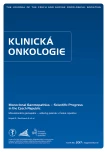Editorial
Published in the journal:
Klin Onkol 2017; 30(Supplementum2): 3
Category:
Editorial
Dear colleagues,
six years passed, and I would like to present our new supplement which was prepared by the researchers of the Myeloma Section of the Czech Hematology Association and the Czech Myeloma Group in cooperation with the team of the Institute of Biostatistics and Analyses at Masaryk University (IBA MU). This supplement is focused on the research in the field of monoclonal gammopathies and multiple myeloma. In the introduction for the previous supplement, I wrote: “Multiple myeloma research progression in the first decade of this century can be described as rapid as development of therapeutic modalities. It is extraordinary how rapidly knowledge from the area of applied research has gone into clinical practice, the so-called bench to bedside strategy. On the contrary, development in the field of basic research is gradual, which stems from the very nature of basic research and complicated oncogenesis of multiple myeloma.” It is easy to say that development in the second decade of the 21st century is similar, but applied research progression became even more intensive and development of the therapeutic modalities is “super rapid”. It is so intensive that it would be enough for another supplement exclusively drug-oriented. Introduction of new drugs into clinical settings is dramatic and creates a lot of pressure on research primarily in the field of standardization of minimal residual disease (MRD) with the highest sensitivity. This supplement of Klinicka onkologie 2017 is focused on the most important research problems and activities in which the Czech Republic is involved and plays a significant role.
Of course, this includes the linking of individual biobanks into one biobank with more than 40,000 archived samples and an extension program enabling researchers to identify easily requested samples serving all researchers in the Czech Republic, as described by Almasi et al. in the introductory article. At the same time, a high world-class standard is reached in the preliminary phase of cell sorting for single cell analysis.
MRD for multiple myeloma can be described as an area of rapid development. In 2011, it was topic for 4-color flowcytometry and a very lab-intensive testing using the ASO PCR method. The efficacy of treatment by which we can achieve MRD negativity with a sensitivity of 10–6 in 80% of patients has greatly accelerated demands in this area. Rihova et al. describes in her publication the development of flowcytometry from the 4-color approach to the 8-color method to the so-called Next Generation Flow. Similar progress has been noted even in genomic methods using next-generation sequencing at the level of individual cells, which is described by Zatopkova et al. The issue is enhanced by the researchers’ efforts to overcome limitations of existing methods requiring bone marrow sampling to assess residual disease by finding a sufficiently sensitive method using a peripheral blood sample, the so-called liquid biopsy, which is especially a major challenge and hope for the future in multiple myeloma. Researchers from Brno are intensively involved in this research, as evidenced by several national and international grants and, in particular, by a summary of the issue in two articles by this group (Kubaczkova et al. and Bezdekova et al.).
Further articles of this supplement are focused on selected innovations in the field of flowcytometry and biomarkers in rare monoclonal gammopathies, AL amyloidosis and Waldenström macroglobulinemia. CRISPR (Clustered Regularly Interspaced Short Palindromic Repeats) method can be considered as one of the major methodological discoveries in the area of manipulation of the genome of recent years. Simicek et al. describe the use of the CRISPR method for specific projects in the field of monoclonal gammopathies in the Czech Republic.
This supplement is concluded with several methodological and result articles focused on the Czech Myeloma Group‘s Registry of Monoclonal Gammopathies, which was founded exactly 10 years ago. In the past 10 years, the benefit of continuous registries has gained importance as it reflects benefits of drugs in real-life better than clinical trials. It should be emphasized that a lot of expert working groups in the Czech Republic reach the world standard in this area, also thanks to the extraordinary conditions related to the existence of the Institute of Biostatistics and Analyses at Masaryk University. Our myeloma registry is one of the largest and highest quality in the world, and I would like to thank very much to the physicians and datamanagers of all participating centers, as well as the analysts and statisticians from IBA MU, mainly Jarkovsky and Brozova, for their excellent systematic long-term work.
I would like to thank all authors, who participated in this supplement. I would like to especially thank Assoc. Prof. Sevcikova for her role in preparation of this supplement. I hope that our articles will be of interest to you.
prof. MUDr. Roman Hajek, CSc.
Head of the Czech Myeloma Group and Myeloma Section of the Czech Hematology Association Czech Medical Association of J. E. Purkyne
Štítky
Dětská onkologie Chirurgie všeobecná OnkologieČlánek vyšel v časopise
Klinická onkologie

2017 Číslo Supplementum2
- Metamizol jako analgetikum první volby: kdy, pro koho, jak a proč?
- Specifika v komunikaci s pacienty s ránou – laická doporučení
- MUDr. Lenka Klimešová: Multioborová vizita může být klíčem k efektivnější perioperační léčbě chronické bolesti
Nejčtenější v tomto čísle
- Analýza minimální reziduální nemoci u mnohočetného myelomu pomocí multiparametrické průtokové cytometrie
- CRISPR ve výzkumu a léčbě mnohočetného myelomu
- Epidemiologie mnohočetného myelomu v České republice
- Biomarkery v amyloidóze lehkého řetězce imunoglobulinů
